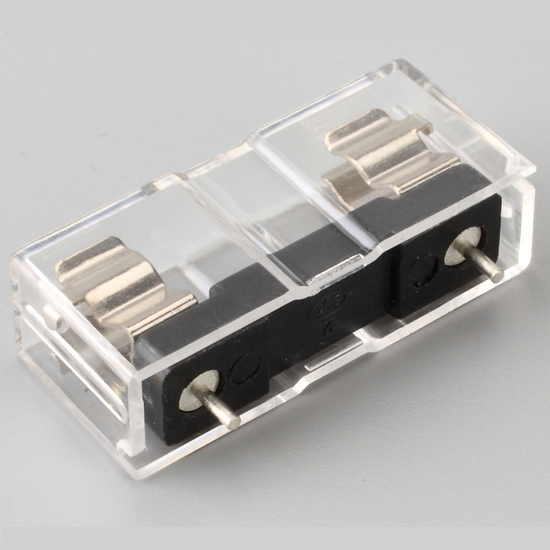Fuse holder manufacturer
We all know that when the current flows through the conductor, the conductor will heat up because there is a certain resistance in the conductor. And the calorific value follows this formula: Q is calorific value, 0.24 is a constant, I is the current flowing through the conductor, R is the resistance of the conductor, and T is the time when the current flows through the conductor. according to this formula, it is not difficult to see the simple working principle of the fuse.
When the material and shape of the fuse are determined, its resistance R is relatively determined (if its temperature coefficient of resistance is not taken into account). When the current flows through it, it heats up, and its calorific value increases as time goes on. The size of the current and resistance determines the speed of heat generation, and the structure and installation of the fuse determine the speed of heat dissipation. If the speed of heat generation is less than the speed of heat dissipation, the fuse will not fuse.
If the rate of heat generation is equal to the rate of heat dissipation, it will not fuse for a long time. If the rate of heat generation is greater than the rate of heat dissipation, then more and more heat will be generated. And because it has a certain specific heat and mass, the increase of heat is shown in the increase of temperature, when the temperature rises above the melting point of the fuse, the fuse will fuse. That's how fuses work.
We should know from this principle that when you design and manufacture fuses, you must carefully study the physical properties of your selected materials and ensure that they have a consistent geometric size. Because these factors play an important role in whether the fuse can work properly. Again, when you use it, be sure to install it correctly.
What is the construction of the fuse? What are the effects of each? What do you want?
A general fuse consists of three parts
The main contents are as follows:
1. It is the core of the fuse, which plays the role of cutting off the current when fusing. The fuse of the same type and specification should have the same material, the same geometric size, the same resistance as much as possible, and the most important thing is that the fuse characteristics should be consistent.
2. it is the electrode part, usually there are two, it is an important part of the connection between the melt and the circuit, it must have good conductivity and should not produce obvious installation contact resistance.
3. It is the part of the bracket, the melt of the fuse is generally slender and soft, and the function of the bracket is to fix the melt and make the three parts into a rigid whole easy to install and use. it must have good mechanical strength, insulation, heat resistance and flame retardancy, and there should be no fracture, deformation, combustion and short circuit in use.
The fuses used in power circuits and high-power equipment have not only three parts of the general fuse, but also arc extinguishing devices, because the circuit protected by this kind of fuse not only has a large working current, and when the melt is fused, the voltage at both ends of the fuse is also very high, which often occurs that the melt has melted (fused) or even vaporized, but the current is not cut off. The reason is that the arc between the two electrodes of the fuse occurs under the action of voltage and current at the moment of the fuse. This arc extinguishing device must have strong insulation and good thermal conductivity, and be negative. Quartz sand is a commonly used arc extinguishing material.
In addition, some fuses have a fuse indicator, which is used to change the appearance of the fuse itself after fuse action (fuse), which is easy to be found by maintenance personnel, such as glowing, discoloration, pop-up solid indicator and so on.
The above is an introduction to how the fuse works. If you want to know more about the fuse holder, please feel free to contact us.
You May Like
Post time: Jun-24-2022



